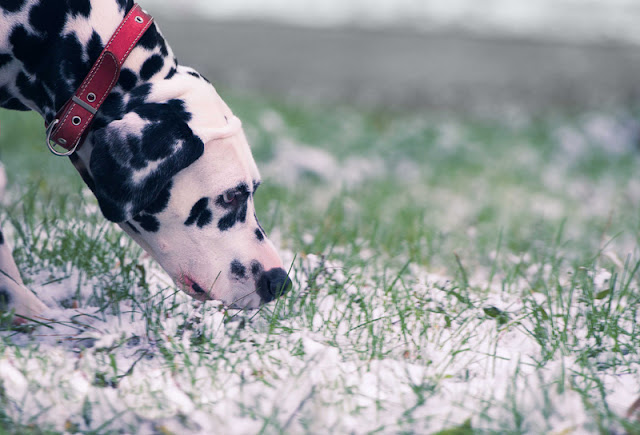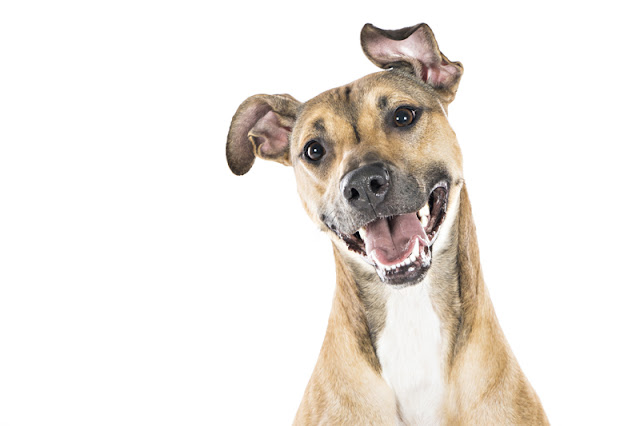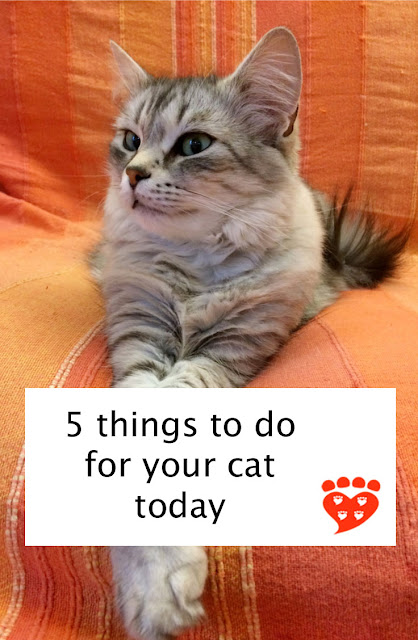Want to make your cat happier? Here are some things you can do right now to make your feline feel blissful.
 |
| Photo: Dmitry Nesterov / Shutterstock |
Cats are wonderful creatures. When we understand them, we can use that information to make them happier. Here are five things to do for your cat today – and a bonus one to work on over time.
1. Make time to play with your cat
11% of cats have no toys, according to one study (Howell et al 2016).
But
the average cat has 7 toys, and toy mice are the most popular. (Strickler and Shull 2014)
Even if your cat has lots of toys of their own, they still like it when their human plays with them. 64% of the owners in Strickler and Shull’s study played with their cat twice a day, but playtime typically lasted 5 or 10 minutes. Amongst people who played with their cat for at least 5 minutes instead of just 1 minute, there were fewer behaviour problems.
But your cat would probably like an even longer play time.
Have you ever felt that when you are moving a toy for your cat, they seem to be hunting it? This is because play satisfies the cat’s predatory instincts.
John Bradshaw PhD, author of Cat Sense and other best-selling books on pets,
told NPR that “The research that we've done suggests that [play] it's almost indistinguishable, that everything that a cat does when it's playing seems to be a part of its normal hunting behavior.”
So when a cat plays, it’s not so much about the cat being sociable with you, it’s really about hunting.
This means they like toys that are like prey in some way – maybe they are furry or have feathers or are mouse-sized or squeak like a mouse or are long so the cat can kick their back legs against it. And cats would like you to move it as if it is real prey for them to chase.
Every cat is an individual, so experiment with different types of toys and different ways of moving them to see what makes your cat engage in play.
And remember that cats can get bored of toys, so you can put some of them away in a cat’s toy box and rotate the toys that are available. (If you have a cat like my tortoiseshell, she will learn to open the box and pick her own toys!).
You might find that multiple sessions of 5 - 10 minutes works best, but you can experiment and see what your cat likes.
Free-ranging cats spend a large part of each day hunting for food, which shows just how important hunting behaviour is to a cat. Strickler and Shull suggest that cats would probably like it if an individual play session lasts for longer than 10 minutes; 30 minutes is the typical length of a time a free-ranging cat spends on a single hunt (although only some of that time would be active chase as the mouse has first to be found). Play keeps your cat active and satisfies that predatory instinct.
So make time to play with your cat!
2. Give your cat a food toy
Another way to engage your cat’s hunting instinct is through the use of food toys. These provide valuable enrichment to our feline friends.
There are many food toys available, including balls with holes in that the cat has to roll to make treats fall out, the mouse-shaped
no bowl, containers that have to be tipped like the
Trixie Mad Scientist
, and things the cat has to paw at to get the treats out like the
Trixie 5-in-1 Activity Center
.
There are food toys for every level of feline ability. If your cat is new to food toys, start with something easy so they don’t get frustrated trying to get at the food. You may also need to use particularly tasty treats to get their interest. Over time, you can make the toys more difficult, and use them to feed all meals instead of providing ‘free’ food in a bowl.
You can also hide the toys around the house so the cat has to hunt for them to get started.
The great thing about food toys is that although there are some fantastic ones on the market, you can also make them for free. For example, make a hole in a cardboard tube, stick paper over one end, put food inside, paper over the other end, and let your cat figure out how to get the food out of the hole.
Only 5% of cats have food puzzle toys according to a survey of the
enrichment people provide for their cats (Alho et al 2016).
Food puzzle toys can help to resolve feline behaviour problems because they provide environmental enrichment that can reduce stress and make the cat more active. (Dantas et al 2016)
Food toys are great for cats because they make them work for their food – completing another part of the predatory sequence.
3. Make sure your cat has nice hiding places
As well as thinking about cats evolving as solitary hunters of prey, we have to remember that cats themselves are prey animals. Which means cats like places they can hide and feel safe.
This is especially important if you have a fearful cat – the kind that runs to hide when people come over to the house.
But all cats need places to hide. In fact, a recent study of
shelter cats’ use of a hiding box and a separate perch found the hiding box was much preferred, so much so that it may be considered a basic need for cats (Ellis et al 2017b).
The kind of hiding place that cats prefer is cat-sized, secluded, and often high up from the ground. It’s a place in which they can feel safe.
Examples of safe hiding places include a cardboard box (e.g. a regular cardboard box laying on its side, or a box specially designed for cats), a perch with a lip or a box to go in on a cat tree, a cat cube or cocoon (many types are available commercially), the cat carrier (if the cat likes it), a space on a shelf, or in a cupboard or wardrobe where the cat has access.
So do a quick survey of the places that are available to your cat as hiding places. Are they in busy parts of the house or does the cat also have hiding places in quieter rooms? Are they cat sized, or are they a bit too big? If your cat has outside access, do they also have safe hiding places in your yard or garden?
You can make existing hiding places more comfortable by adding a fleecy blanket or towel for the cat to curl up on.
And if you think your cat might not have enough spaces, see about providing some extra ones. It may be as simple as giving them a cardboard box and putting it on its side, or putting it upside down with a hole cut out for them to go in and out.
4. Use scents as enrichment
Did you know that your cat has an amazing nose, and on top of that they also have a vomeronasal organ that detects pheromones – chemical signals that have meaning to cats? This means that
scent is far more important in your cat’s life than you realize.
When your cat rubs its head on you or the furniture, it is leaving pheromones behind. You may even notice a little brown mark on the wall where your cat rubs often. Don’t clean it up! Or at least don’t clean all of them up at once. Those familiar chemical signals that the cat is depositing help them to feel safe and secure.
Everyone is familiar with catnip toys, but there are other scents that many cats like too, so you could try
valerian, silver vine or honeysuckle and see if your cat responds to those. Almost all cats will visibly respond to at least one of these scents.
 |
| Photo: Dmitry Nesterov / Shutterstock |
You can find valerian in some cat toys, silver vine is available as a stick or powder, and honeysuckle as blocks of wood of various sizes. They may not be in your local pet store, so you may have to look for them online.
You can buy catnip that is mixed with other scents such as lavender, so if your cat likes catnip this is another way to provide different scents as enrichment.
In fact a recent study found that although only some cats respond to catnip by rolling around, other cats do respond, just in a passive way such as being in a Sphinx position or being less active and miaowing less (Espin-Iturbe et al 2017).
Another way to provide scent as enrichment if you have an indoor cat is to open the window for them to let them smell the air from outside. Obviously, do this in a safe way so they can’t escape – and remember that screens are not necessarily cat-safe. But you only need to open the window a chink to let the outside smells in.
5. Clean the litter tray
Did you notice how I saved the most glamorous one til last?!!
I know what you're thinking. The other four are all fun, and this one... not so much.
But the litter tray is a serious matter for cats. Many house-soiling issues are due to problems with the litter tray (but if your cat suddenly starts making a mess in the house, it’s important to see a vet in case a medical issue is the cause). It’s an important issue because inappropriate toileting behaviour is a common reason for cats to be surrendered to animal shelters.
26% of pet cat owners clean their litter box once a day, but 11% only clean it once a week and 5% less frequently than that (Howell et al 2016). So there is plenty of scope for improvement amongst the average cat owner. And it really doesn't take long.
Cats prefer a clean litter box. It’s not so much the smell they object to, but the presence of urine or faeces that is visually unappealing and physically in the way (Ellis et al 2017).
Cats will typically still use a litter box they are not very happy with, but signs they are not so keen on it include being hesitant to go in it, going in and then out of it, keeping a paw out of it while they eliminate, and spending a long time over elimination (McGowan et al 2017). This study also found that cats may hold their urine if they are not happy with their litter box, making them vulnerable to urinary tract infections.
So you should scoop your litter tray every day, but preferably twice a day, and clean the litter tray thoroughly once a week.
6. Bonus: Teach your cat to like their carrier
This is a bonus item because it is not something you can achieve in a day, especially if your cat is already scared of their carrier. Which they might be if it only ever predicts visits to the vet.
But one thing you can do today is get the carrier out, have a look at it and see if it’s suitable, leave it out somewhere so it becomes a normal thing – and make a plan to teach your cat to like it. This is so important because
training a cat to use their carrier makes vet visits less stressful.
The best kind of carrier is one that is secure but where the top half can be detached from the bottom half. This means that at the vet, you can simply remove the top and the vet can examine the cat in the bottom of the carrier. Some cats will feel safer like this than if they have to come completely out of the carrier. (See more tips in
8 ways to help your cat go to the vet).
If the carrier always means an unpleasant trip to the vet, you can’t really blame a cat for not liking it. So you need to break that association. If your cat is terrified of the carrier you already have, you might find it best to start afresh with a new carrier.
Put a nice fleecy blanket or towel in the bottom so it is nice and cosy. And then leave it somewhere in the house where it will become a familiar thing. You might need to prop the door open so it can’t accidentally close behind the cat when they go in.
You can leave treats inside it to encourage your cat to go in. But for many cats even this will be too scary, so you may have to start by leaving treats in the general vicinity of the carrier. Once the cat is relaxed and comfortable collecting those treats, you can put treats a bit closer, until eventually the cat will approach the carrier.
This is a slow process. For a full explanation of how to teach your cat to like their carrier, I recommend
this post by Sarah Ellis PhD. (You might like to read my
interview with Dr. Sarah Ellis for more tips on training your cat).
Summary of tips for your cat
So there you have it – five things to do for your cat today, and a sixth one to work on over time. Play with your cat, use food toys, provide safe hiding places, use scent as enrichment, and remember to scoop the litter tray! Then start thinking about how to teach your cat to like their carrier.
These tips will provide enrichment for your cat, help your cat be more active and help them to feel safe and secure.
Of course, every cat is an individual and has their own preferences as all cat lovers know well. In the comments, let me know which are your cat’s favourite toys, and where is your cat’s favourite hiding place?
To learn more about how science can help you have a happier cat or dog,
subscribe to Companion Animal Psychology.
References
Alho, A. M., Pontes, J., & Pomba, C. (2016). Guardians' Knowledge and Husbandry Practices of Feline Environmental Enrichment. Journal of applied animal welfare science, 19(2), 115-125.
http://dx.doi.org/10.1080/10888705.2015.1117976Bol, S., Caspers, J., Buckingham, L., Anderson-Shelton, G. D., Ridgway, C., Buffington, C. T., ... & Bunnik, E. M. (2017). Responsiveness of cats (Felidae) to silver vine (Actinidia polygama), Tatarian honeysuckle (Lonicera tatarica), valerian (Valeriana officinalis) and catnip (Nepeta cataria). BMC veterinary research, 13(1), 70.
https://doi.org/10.1186/s12917-017-0987-6Ellis, J. J., McGowan, R. T. S., & Martin, F. (2017). Does previous use affect litter box appeal in multi-cat households?. Behavioural Processes.
https://doi.org/10.1016/j.beproc.2017.02.008Ellis, J. J., Stryhn, H., Spears, J., & Cockram, M. S. (2017b). Environmental enrichment choices of shelter cats. Behavioural Processes.
https://doi.org/10.1016/j.beproc.2017.03.023Espín-Iturbe, L. T., Yañez, B. A. L., García, A. C., Canseco-Sedano, R., Vázquez-Hernández, M., & Coria-Avila, G. A. (2017). Active and passive responses to catnip (Nepeta cataria) are affected by age, sex and early gonadectomy in male and female cats.
Behavioural Processes,
142, 110-115.
https://doi.org/10.1016/j.beproc.2017.06.008Howell, T. J., Mornement, K., & Bennett, P. C. (2016). Pet cat management practices among a representative sample of owners in Victoria, Australia. Journal of Veterinary Behavior: Clinical Applications and Research, 11, 42-49.
https://doi.org/10.1016/j.jveb.2015.10.006McGowan, R. T., Ellis, J. J., Bensky, M. K., & Martin, F. (2017). The ins and outs of the litter box: A detailed ethogram of cat elimination behavior in two contrasting environments. Applied Animal Behaviour Science.
https://doi.org/10.1016/j.applanim.2017.05.009Strickler, B. L., & Shull, E. A. (2014). An owner survey of toys, activities, and behavior problems in indoor cats. Journal of Veterinary Behavior: Clinical Applications and Research, 9(5), 207-214.
https://doi.org/10.1016/j.jveb.2014.06.005As an Amazon Associate I earn from qualifying purchases. As an Etsy affiliate, I earn from qualifying Etsy purchases.
















